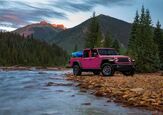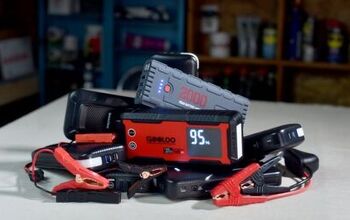What Gear Do I Need For My Overlanding Rig?

Overlanding might be glorified off-road car camping, but there’s no doubt it’s a sizable undertaking.
As it and off-roading have grown in popularity as more adventurers seek to explore rugged, off-the-grid terrain, the kit that goes along with it has expanded and improved drastically. Not all of it is necessary, but to safely navigate challenging environments, the right accessories and gear are crucial. From vehicle protection and recovery tools to comfort-enhancing equipment, here’s a comprehensive guide to what you’ll need on your overland adventures.
SEE ALSO: Choosing The Best Vehicle For Overlanding
1. Overlanding Essentials: Gearing Up for Adventure
Overlanding is about long-distance travel with self-reliance at its core. Unlike traditional off-roading, it often involves living out of your vehicle for extended periods. With that in mind, here are some of the key accessories that will ensure both your safety and comfort:
- Roof Rack and Cargo Storage: Efficient storage is a must for overlanding. Roof racks, cargo baskets, and rooftop storage solutions help you carry everything from extra fuel cans to camping gear without taking up valuable space inside the vehicle.
- Roof-Top Tent or Ground Tent: Roof-top tents are a favorite among overlanders because they keep you elevated from the ground, safe from animals, and provide a fast, easy setup. Ground tents are an alternative but take longer to set up and offer less convenience.
- Dual Battery System or Portable Power Station: Keeping your electronics powered is vital on longer trips. A dual battery system or a high-capacity portable power station allows you to run a fridge, charge devices, and use lights without draining your main vehicle battery.
- Fridge/Freezer: Unlike a traditional cooler, a fridge/freezer keeps food and drinks cold or frozen without the hassle of melting ice. These are particularly helpful on multi-day trips where fresh food and drinks are hard to come by.
- Awning and Shade Solutions: Overland trips can take you to some extremely hot environments. A pull-out awning mounted to your roof rack provides instant shade and protection from the elements, making your campsite more comfortable.
2. Off-Road Recovery Gear: Is a Hi-Lift Jack Necessary?
Recovery gear is essential for any off-roading or overlanding trip. While you’ll hopefully avoid getting stuck, it's wise to prepare for the worst. One of the most debated pieces of recovery gear is the Hi-Lift Jack.
Hi-Lift Jack: A Must-Have or Overrated?
A Hi-Lift Jack is an iconic tool in off-roading, capable of lifting a vehicle high enough to help recover from being bogged in deep mud, sand, or snow. It’s also useful for changing tires in difficult terrain where standard jacks won’t reach. That said, some argue that it’s bulky, can be dangerous if improperly used, and might not be necessary if you're in less extreme conditions.
If you primarily stick to well-traveled trails and less extreme off-roading, a bottle jack or a smaller off-road-specific jack may suffice. But if you’re planning on exploring isolated, unpredictable terrain, a Hi-Lift Jack could be a lifesaver. The key is learning how to use it safely—improper use can result in injury.
- Recovery Straps and Shackles: Alongside your Hi-Lift Jack, you’ll need a set of recovery straps (often called tow straps) and D-ring shackles. These allow you to recover your vehicle or assist others in recovery. Ensure your straps are rated for the weight of your vehicle, and invest in high-quality shackles that won't snap under pressure.
- Traction Boards: Traction boards are another must-have recovery tool. When you get stuck in sand, snow, or mud, these boards provide immediate traction under your tires, helping you get moving again without the need for a tow or winch.
- Air Compressor and Tire Deflator: Airing down your tires increases their surface area, providing better traction on loose surfaces. An air compressor lets you air back up when you return to solid ground. Tire deflators allow you to quickly reduce tire pressure before tackling difficult terrain.
- Winch: A winch is indispensable for more advanced off-roading and overlanding. Mounted to the front bumper, it allows you to recover yourself from situations where other vehicles or recovery gear may not be enough. Pair it with a tree strap and snatch block for maximum versatility.
What we'll say is this: We generally subscribe to the mindset that "It's better to have it and not need it than to need it and not have it," but be sure to keep that in check. Bringing along all of the recovery equipment in the world, it's easy to bring an unnecessary assortment that quickly helps the vehicle approach its GVWR. Carefully consider what you bring along, and it's sometimes good to discuss with friends and off-roading buddies what they're bringing along so you can minimize overlap.
3. Armor: Skid Plates and Rock Sliders for Off-Road Protection
Off-roading can be brutal on your vehicle. Rocks, logs, and uneven terrain can easily cause damage to your undercarriage. That’s where vehicle armor comes into play, particularly skid plates and rock sliders.
Skid Plates: Shielding the Undercarriage
- Skid Plates: designed to protect your vehicle’s vulnerable underbelly, including the oil pan, transmission, fuel tank, and transfer case. In many off-roading environments, hitting a rock or log is almost inevitable, and the damage to these components can be costly. Skid plates provide peace of mind by preventing punctures or dents in these critical parts.
- When outfitting your vehicle, prioritize skid plates that protect:
- Engine and Transmission: These are essential as damage here can leave you stranded.
- Fuel Tank: A punctured fuel tank can end a trip, not to mention pose a fire hazard.
- Transfer Case: For 4WD vehicles, the transfer case is crucial for power distribution, and a damaged one can disable your off-roading capabilities.
Rock Sliders: Safeguarding Your Sides
- Rock Sliders are a form of armor that mounts along the sides of your vehicle, protecting your rocker panels and lower doors. In rock crawling or heavily wooded areas, rocks and trees can dent or crush the sides of your vehicle. Rock sliders prevent this damage and also provide a solid step for accessing roof racks or gear. Some sliders are designed to double as steps, which is a bonus for lifted vehicles.
- Bumpers and Brush Guards: Upgrading your front and rear bumpers with heavy-duty steel versions can prevent damage from impacts, and provide mounting points for winches and recovery gear. Brush guards protect your headlights and grille from damage caused by branches and other debris on the trail.
Our take is that skid plates and rock sliders are indispensable. Don't cheap out on these, and if you have any chance of crossing terrain with large rocks, downed trees, or any other obstacles that can contact and/or damage the underside of the vehicle, procure protection sooner rather than later.
4. Additional Gear for a Safe and Comfortable Trip
Beyond the recovery gear and armor, here are a few more pieces of equipment to consider:
- GPS Navigation and Satellite Communication: Off-road and overland routes often take you out of cell service range. A reliable GPS unit or smartphone navigation apps designed for off-roading are critical. Consider a satellite communication device for emergencies. Likewise, a solid navigation and mapping app like onX is great for planning and tracking routes.
- Water Storage and Filtration: Ensuring you have enough water is critical for overlanding. Water storage tanks or portable containers are essential, and a water filtration system is useful when you need to source water from rivers or lakes.
- Tool Kit and Spare Parts: A basic tool kit, including wrenches, pliers, and tire repair kits, is essential for field repairs. Carry spare parts such as extra hoses, belts, and fluids, particularly if you’re traveling in remote areas where help could be hours or days away.
Do I Really Need All This Gear For Overlanding?
Equipping your vehicle with the right gear is crucial for a successful and safe overlanding or off-roading experience. Whether it’s recovery tools like a Hi-Lift Jack, vehicle protection with skid plates and rock sliders, or comfort-enhancing equipment like rooftop tents and fridges, each piece of gear plays a vital role. Tailor your setup to the terrain you plan to explore and the length of your trip to ensure you’re well-prepared for whatever challenges come your way.
Become an AutoGuide insider. Get the latest from the automotive world first by subscribing to our newsletter here.

Ross hosts The Hooniverse Podcast. He has been in the off-road world since he was a kid riding in the back of his dad’s YJ Wrangler. He works in marketing by day and in his free time contributes to Hooniverse, AutoGuide, and ATV.com, and in the past has contributed to UTV Driver, ATV Rider, and Everyday Driver. Ross drives a 2018 Lexus GX460 that is an ongoing build project featured on multiple websites and the podcast.
More by Ross Ballot







































Comments
Join the conversation